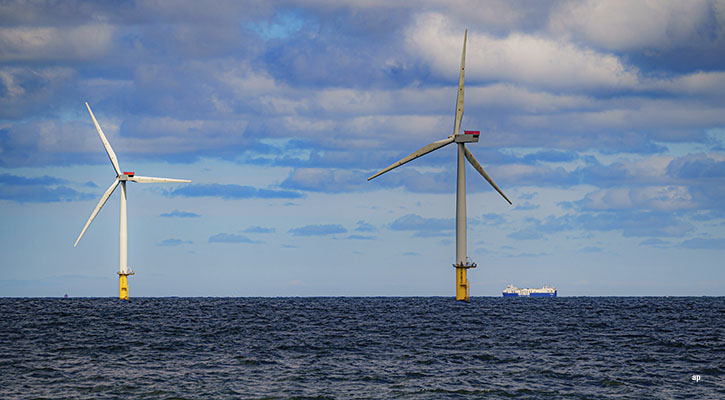
Wind energy is crucial in the transition to net zero. Its attributes as a renewable energy source, coupled with its ability to produce electricity without emitting greenhouse gases, underscore its importance. But just as the world need more clean energy than ever, soaring costs are derailing offshore wind projects, threatening to push the climate change goals even further away.
"While we acknowledge that wind energy has a critical role to play in future energy mix, we see several structural issues and risks to the economics for operators," says Andrea Carzana, co-manager of the Aviva Investors Global Climate Transition Equity fund to Morningstar.
Currently, renewable energy supplies about 20% of total energy demand in Europe, meaning the updated target of 42.5% by 2030 is already ambitious. However, several of the tailwinds that propelled it to its current level in the past decade are shifting and becoming headwinds.
"Global inflation and higher rates are the most notable as both substantially increase costs, which threaten future and current project development, particularly offshore wind," Morningstar analysts concluded in a sector report in October.
"These are compounded by continued permit delays throughout Europe while the introduction of greater subsidies makes the US a more appealing place to invest."
Danish ESG-giant Ørsted (ORSTED), the world's largest developer of offshore wind power, takes centre stage in this unfolding drama. With failed projects, multi-billion impairments, supply chain delays, increased interest rates, and a plummeting share price, Ørsted exemplifies the sector's difficulties.
"These challenges are by no means unique to Ørsted, but some of its competitors have more diversified revenue streams," Morningstar analyst Matthew Donen explains.
Vestas (VWS) on the other hand, the world's biggest wind turbine maker, increased its prices on the back of higher raw material prices and turned to profit in the third quarter.
Soaring Costs
Offshore wind costs have soared 50% because of higher construction and capital costs, making it difficult for developers and suppliers to secure financing for projects at profitable margins.
A unit of Spain's Iberdrola (IBE) cancelled a contract to sell power from a planned wind farm off the coast of Massachusetts earlier this year. Ørsted also lost a bid to provide offshore wind power to Rhode Island, whose main utility said rising costs made the proposal too expensive.
The largest offshore wind farm project in the UK abruptly halted this summer when the Swedish state-owned utility Vattenfall suspended work on its Norfolk Boreas site due to a 40% increase in project costs. As a result, Vattenfall will book impairment charges of SEK 5.5 billion (£416 million). In September, an auction for UK offshore wind projects attracted no bids, a setback to the government’s plans to increase offshore wind from 14GW today to 50GW by 2030. Potential bidders said the economics of the projects currently don’t make sense for developers.
"Companies across the value chain are […] writing down the value of their offshore wind assets, projects are becoming onerous and there is a genuine prospect of operators walking away from projects due to poor economics which will delay the much-needed ramp-up of wind energy," says Andrea Carzana, co-manager of the Aviva Investors Global Climate Transition Equity fund.
A Fair Wind Blowing?
While the sector faces persistent challenges, there is a glimmer of hope on the horizon. Global demand for offshore wind farms is poised to surge, with governments worldwide committing to substantial wind power capacity increases.
In Europe, nations including the UK, Germany and the Netherlands vowed earlier this year to reach a combined 120GW of wind power by 2030, more than quadruple the current capacity. President Joe Biden aims to have 30GW of offshore wind farms installed in the US by the end of the decade, up from basically nothing today.
But if costs keep rising, it will ultimately mean higher bills for consumers, who are still reeling from the energy price and inflation shock of 2022.
Addressing the soaring costs, the UK recently took direct action to help with funding, bumping up the support price for new offshore wind farms. Germany will also make it easier for green energy firms to get on the grid. The European Commission has similarly acknowledged the troubling situation and published an action plan late last month that unveiled actions to accelerate deployment through faster permitting and access to finance.
"Although the industry is going through a painful reset, there is little doubt offshore wind remains a vital tool for the energy transition,” Charlie Thomas, CIO at EdenTree, said to Funds Europe.
Inflation figures around the world are on a downward trend, indicating that lower interest rates might be on the near horizon. This, in combination with various incentives for the offshore wind sector, might just be the saviour that the sector needs.
"Both interest rates and inflation seem to have reached a plateau, which provides some certainty in costs, favoring investment," says Carla Ribeiro, head of offshore wind advisory for UK and Ireland at consultancy firm Ramboli, according to Bloomberg.

























